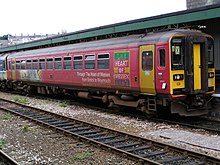| Revision as of 09:12, 30 September 2005 editEnotayokel (talk | contribs)Extended confirmed users1,429 editsNo edit summary← Previous edit | Revision as of 16:21, 2 October 2005 edit undo80.229.8.186 (talk) →Current Operations: i'm guessing 3326 isn't called 'knobcheez'Next edit → | ||
| Line 22: | Line 22: | ||
| *153309 - ] | *153309 - ] | ||
| *153311 - ] | *153311 - ] | ||
| ⚫ | *153314 - ] | ||
| || | || | ||
| |valign="top"| | |valign="top"| | ||
| ⚫ | *153314 - ] | ||
| *153322 - ] | *153322 - ] | ||
| *153326 - ] | |||
| *153335 - ] | *153335 - ] | ||
| |} | |} | ||
Revision as of 16:21, 2 October 2005






The British Rail Class 153 "Super-Sprinter" is a diesel multiple unit. These single cars units were originally built as two-car Class 155 units by Leyland from 1987-88, but were converted by Hunslet-Barclay at Kilmarnock from 1991-92. In a tradition following on from the Class 121 and Class 122 units, these units are sometimes referred to as "Bubble-cars", and are also sometimes derogatorily referred to as "Dogboxes". The layout of the original non-cab ends was subtly different from the original cab end, so the ends are noticeably different, and the vehicle not symmetrical. The new cab is significantly smaller the the original Leyland cab and pushes back into the door area, this can lead to slow boarding
Units are numbered in the range 153301-335 and 153351-385. Individual cars are numbered 52301-335 and 57351-385 (originally 57301-335), with the last three digits corresponding to the unit number.
Current Operations
Upon privatisation of British Rail, the Class 153 fleet was divided amongst several different operators.
Anglia Railways / One Railway
Anglia Railways inherited a small fleet of seven units, for local services in Suffolk and Norfolk. Services operated by these units included Ipswich to Cambridge, Peterborough and Felixstowe, the East Suffolk Line (Ipswich to Lowestoft), the Wherry Lines (Norwich to Great Yarmouth/Lowestoft), and the Bittern Line (Norwich to Cromer). One set was also hired to First Great Eastern for use on the Sudbury branch to Sudbury.
Anglia Railways named its Class 153 fleet after famous local figures:
|
|
In 2003, Anglia started to refurbish its fleet, and repaint them in Anglia Railways livery. However, only three (unit nos. 153309/322/335) were completed.
In 2004, Anglia became part of the One Railway franchise operated by the National Express Group. In early-2005, two units were due to be transferred to other franchises, the first being unit no. 153311 to Arriva Trains Wales followed later by 153326. Both of these units carry the Regional Railways Livery.
Arriva Trains Wales
Central Trains
Northern
The new Northern Rail franchise started operations in December 2004. They inherited the fleets previously operated by Arriva Trains Northern and First North Western, whose routes the new franchise incorporated.
Northern inherited a fleet of eight units from First North Western (FNW) units, which are used on local services around Manchester, Chester and on Lancaster to Barrow-in-Furness to Carlisle services. The fleet was repainted in the now obsolete North Western Trains blue and gold livery. Prior to becoming part of Northern, four former FNW units were transferred to the Arriva Trains Wales franchise, since the lines operated by FNW in Wales were transferred to this new company.
A larger fleet of twelve units were inherited from Arriva Trains Northern (ATN). These have been refurbished and carry the now obsolete Arriva Trains livery. They are used on various local services around Leeds, Doncaster, York and Newcastle-upon-Tyne.
Wessex Trains
Wessex Trains inherited its fleet of 13 units from its predecessor, Wales and West. Units are operated on local services in Cornwall, Devon, and around Bristol. They are also used on Bristol Temple Meads to Weymouth, Southampton and Worcester services. Units carry one of two distinctive liveries, which advertise the routes on which they work.
- Devon and Cornwall - local services in Cornwall and Devon (units 153302/308/374/377/380/382)
- Heart of Wessex - Bristol to Weymouth line (units 153305/318/355/368/370/372/373)
In mid-2004, Wessex Trains received a further two units from Central Trains (unit nos. 153329/369) to allow it to lengthen some services.
Fleet Details
| Operator | No. of units | Unit nos. |
|---|---|---|
Arriva Trains Wales
|
13 (2) |
153310-312/313/320/321/323/326/327/353/361/362/367
|
| Central Trains | 16 | 153325/333/334/354/356/364-366/371/375/376/379/381/383-385 |
Northern Rail
|
20 (12) |
153301/304/307/315-317/319/324/328/330-332/351/352/357-360/363/378
|
| One Railway | 5 | 153306/309/314/322/335 |
Wessex Trains
|
15 (2) |
153302/305/308/318/329/355/368-370/372-374/377/380/382
|
| Diesel and alternative fuel multiple units of Great Britain | |
|---|---|
| Pre-TOPS | |
| First generation | |
| Second generation | |
| Post-privatisation | |
| Diesel-electric | |
| Alternative fuel | |
| Bi-mode | |
| First generation (original TOPS) | |
| Diesel-electric (original TOPS) | |
| Southern Region designations | |
| Design families | |